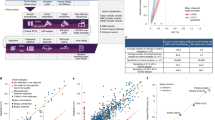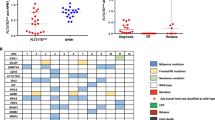Abstract
Somatic mutation of the FLT3 gene as an internal tandem duplication (ITD) of the juxtamembrane domain-coding sequence causes constitutive tyrosine phosphorylation and activation. Tumor-specific DNA has been documented in the sera of patients with solid tumors even when it is in an early stage. We compared the detection of FLT3 ITD in DNA extracted from cells of bone marrow (BM) aspirations with DNA extracted from peripheral blood (PB) plasma in patients newly diagnosed with acute myeloid leukemia (AML; 85 patients), myelodysplastic syndrome (MDS; 16 patients), and acute lymphocytic leukemia (ALL; 16 patients). FLT3 ITD was detected in 18 (21%) AML samples and in one (6%) MDS sample in both cellular and plasma DNA but in none of the ALL samples. Hemizygous/homozygous FLT3 ITD was detected in five (28%) of the FLT3 ITD-positive AML using plasma DNA, whereas only four of these cases showed hemizygous/homozygous FLT3 ITD using cellular DNA. The presence of FLT3 ITD was associated with significantly shorter survival (P = 0.02) when only patients younger than 50 years of age (48 AML+MDS patients) were considered. This finding was independent of cytogenetics in this age group. However, patients with the FLT3 ITD hemizygous/homozygous phenotype had even shorter survival (P = <0.001). As expected, the presence of FLT3 ITD correlated with higher white blood cell (WBC) counts. These data demonstrate that plasma DNA is a reliable alternative resource for detecting FLT3ITD, especially the hemizygous/homozygous genotype. Furthermore, the data derived from this study support the notion that the presence of FLT3 ITD in conjunction with the absence of the wild-type FLT3 allele predicts an especially poor prognosis for patients with AML.
This is a preview of subscription content, access via your institution
Access options
Subscribe to this journal
Receive 12 print issues and online access
$259.00 per year
only $21.58 per issue
Buy this article
- Purchase on Springer Link
- Instant access to full article PDF
Prices may be subject to local taxes which are calculated during checkout




Similar content being viewed by others
References
Mathews, W, Jordan, CT, Wiegand, GW, Pardoll, D & Lemischka, IR A receptor tyrosine kinase specific to hematopoietic stem and progenitor cell-enriched populations. Cell, (1991). 65, 1143–1152.
Rosnet, O, Mattei, MG, Marchetto, S & Birnbaum, D. Isolation and chromosomal localization of a novel FMS-like tyrosine kinase gene. Genomics, (1991). 9, 380–385.
Small, D, Levenstein, M & Kim, E STK-1, the human homolog of FLK-2/FLT3, is selectively expressed in CD34+ human bone marrow cells and is involved in the proliferation of early progenitor stem cells. Proc Natl Acad Sci USA, (1993). 91, 459–463.
Lyman, SD, Marmes, L, Zappone, J, Sleath, PR, Beckman, MP & Bird, T Characterization of the protein encoded by the FLT3 (flk2) receptor-like tyrosine kinase gene. Oncogene, (1993). 8, 815–822.
Rosnet, O, Schiff, C, Pubusque, MJ, Marchetto, S, Tonnelle, C, Toiran, Y, Birg, F & Birnbaum, D Human FLT3/FLK2 gene: cDNA cloning and expression in hematopoietic cells. Blood, (1993). 82, 1110–1119.
McKenna, HJ, Smith, FO, Brasel, K, Hirshstein, D, Bernstein, ID, Williams, DE & Lyman, SD Effects of FLT3 ligand on acute myeloid and lymphocytic leukemic blasts from children. Exp Hematol, (1996). 24, 378–385.
Lisovskey, M, Estrov, Z, Shang, X, Consoli, U, Sanchez-Williams, G, Snell, V, Munker, R, Goodacre, A, Savchenko, V & Andreef, M FLT 3 ligand stimulates proliferation and inhibits apoptosis of acute myeloid leukemia cells: regulation of Bcl-2 and Bax. Blood, (1996). 88, 3987–3997.
Stacchini, A, Fubini, L, Severino, A, Sanavio, F, Aglietta, M & Piacibello, W Expression of type III receptor tyrosine kinases FLT3 and KIT and responses to their ligands by acute myeloid leukemia blasts. Leukemia, (1996). 10, 1584–1591.
Dresler, HG Expression of FLT3 receptor and response to FLT3 ligand by leukemic cells. Leukemia, (1996). 10, 588–599.
Dehmel, U, Zaborski, M, Meierhoff, G, Rosnet, O, Birnbaum, D, Ludwig, WD, Quentmeier, H & Drexler, HG Effects of FLT3 ligand on human leukemia cells. Leukemia, (1996). 10, 261–270.
Kiyoi, H, Kanano, Y, Yokota, S, Minami, S, Miyawaki, S, Asou, N, Kuriyama, K, Jinnai, I, Shimazaki, C, Akiyama, H, Saito, K, Oh, H, Motoji, T, Omoto, E, Saito, H, Ohno, R & Ueda, R Prognostic implication of FLT3 and N-RAS gene mutations in acute myeloid leukemia. Blood, (1999). 93, 3074–3080.
Brasel, K, Escobar, S, Anderberg, R, de Vries, P, Gurss, HJ & Lyman, SD Expression of the FLT3 receptor and its ligand on hematopoietic cells. Leukemia, (1996). 9, 1212–1218.
Jamal, R, Taketani, T, Taki, T, Bessho, F, Hongo, T, Hamaguchi, H, Horiike, S, Taniwaki, M, Hanada, R, Nakamura, H & Hayashi, Y Coduplication of the MLL and FLT3 genes in patients with acute myeloid leukemia. Genes Chromosomes Cancer, (2001). 2, 187–190.
Rosnet, O, Mattei, MG, Marchetto, S & Birnbaum, D Isolation and chromosomal localization of a novel FMS-like tyrosine kinase gene. Genomics, (1991). 9, 380–385.
Stirewalt, DL, Kopecky, KJ, Meshinchi, S, Appelbaum, FR, Slovak, ML, Willman, CL & Radich, JP FLT3, RAS, and TP53 mutations in elderly patients with acute myeloid leukemia. Blood, (2001). 97, 3589–3595.
Kioyi, H, Towatari, M, Yokota, S, Hamaguchi, M, Ohno, R, Saito, H & Naoe, T Internal tandem duplication of the FLT3 gene is a novel modality of elongation mutation which causes constitutive activation of the product. Leukemia, (1998). 12, 1333–1337.
Fenski, R, Flesch, K, Serve, S, Mizuki, M, Oelmann, E, Kratz-Albers, K, Kienast, J, Leo, R, Schwartz, S, Berdel, WE & Serve, H Constitutive activation of FLT3 in acute myeloid leukaemia and its consequences for growth of 32D cells. Br J Haematol, (2000). 108, 322–330.
Tse, KF, Mukherjee, G & Small, D Constitutive activation of FLT3 stimulates multiple intracellular signal transducers and results in transformation. Leukemia, (2000). 14, 1766–1776.
Hayakawa, F, Kiyoi, H, Tanimoto, M, Kitamura, T, Saito, H & Naoe, T Tandem-duplicated FLT3 constitutively activates STAT5 and MAP kinase and introduces autonomous cell growth in IL-3-dependent cell lines. Oncogene, (2000). 19, 624–631.
Nakao, M, Yokota, S, Iwai, T, Kaneko, H, Horiike, S, Kashima, K, Sonoda, Y, Fujimoto, T & Misawa, S Internal tandem duplication of the FLT3 gene found in acute myeloid leukemia. Leukemia, (1996). 10, 1911–1918.
Rombouts, W, Blokland, I, Lowenberg, B & Plemacher, R Biological characteristic and prognosis of adult acute myeloid leukemia with internal tandem duplications in the FLT3 gene. Leukemia, (2000). 14, 675–683.
Kottaridis, P, Gale, R & Frew, M The presence of a FLT3 mutation in AML adds important prognostic information to cytogenetic risk group and response to the first cycle of chemotherapy: analysis of 854 patients from the MRC AML 10 and 12 trials. Blood, (2000). 96, 825a
Meshinchi, S, Woods, W, Stirewalt, D, Sweetser, DA, Buckley, JD, Tjoa, TK, Bernstein, ID & Radich, JP Prevalence and prognostic significance of FLT3 internal tandem duplication in pediatric acute myeloid leukemia. Blood, (2001). 97, 89–94.
Rombouts, WJC, Broyl, A, Martens, ACM, Slater, R & Ploemacher, RE Human acute myeloid leukemia cells with internal tandem duplications in the FLT3 gene show reduced proliferative ability in stroma supported long-term cultures. Leukemia, (1999). 13, 1071–1078.
Whitman, SP, Archer, KJ, Feng, L, Baldus, C, Becknell, B, Carlson, BD, Carroll, AJ, Mrozek, K, Vardiman, JW, George, SL, Kolitz, JE, Larson, RA, Bloomfield, CD & Caligiuri, MA Absence of the wild-type allele predicts poor prognosis in adult de novo acute myeloid leukemia with normal cytogenetics and the internal tandem duplication of FLT3: a cancer and leukemia group B study. Cancer Res, (2001). 61, 7233–7239.
Mauritzson, N, Johansson, B, Rylander, L, Albin, M, Stromberg, U, Billstrom, R, Ahlgren, T, Mikoczy, Z, Mitelman, F, Hagmar, L & Nilsson, PG The prognostic impact of karyotypic subgroups in myelodysplastic syndromes is strongly modified by sex. Br J Haematol, (2001). 113, 347–356.
Chen, X, Bonnefoi, H, Diebold-Berger, S, Lyautey, J, Lederrey, C, Faltin-Traub, E, Stroun, M & Anker, P Detecting tumor-related alterations in plasma or serum DNA of patients diagnosed with breast cancer. Clin Cancer Res, (1999). 5, 2297–2303.
Nakayama, T, Taback, B, Nguyen, DH, Chi, DD, Morton, DL, Fujiwara, Y & Hoon, DS Clinical significance of circulating DNA microsatellite markers in plasma of melanoma patients. Ann N Y Acad Sci, (2000). 906, 87–98.
Starosktik, P, Manshouri, T, O'Brien, S, Freireich, E, Kantarjian, H, Haidar, M, Lerner, S, Keating, M & Albitar, M Deficiency of the ATM protein expression defines an aggressive subgroup of B-cell chronic lymphocytic leukemia. Cancer Res, (1998). 58, 4552–4557.
Author information
Authors and Affiliations
Rights and permissions
About this article
Cite this article
Jilani, I., Estey, E., Manshuri, T. et al. Better detection of FLT3 internal tandem duplication using peripheral blood plasma DNA. Leukemia 17, 114–119 (2003). https://doi.org/10.1038/sj.leu.2402743
Received:
Accepted:
Published:
Issue Date:
DOI: https://doi.org/10.1038/sj.leu.2402743
Keywords
This article is cited by
-
Immune signature drives leukemia escape and relapse after hematopoietic cell transplantation
Nature Medicine (2019)
-
Prevalence of somatic mutations in patients with aplastic anemia using peripheral blood cfDNA as compared with BM
Leukemia (2018)
-
Cell free nucleic acids as diagnostic and prognostic marker in leukemia
memo - Magazine of European Medical Oncology (2018)
-
MYC-dependent downregulation of telomerase by FLT3 inhibitors is required for their therapeutic efficacy on acute myeloid leukemia
Annals of Hematology (2018)
-
FLT3: ITDoes matter in leukemia
Leukemia (2003)



